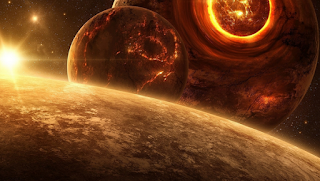Space exploration is a grand adventure. Its mystery has always captivated us and the inevitable discoveries to come will add to the many cosmological insights we already have.
Today we're going to explore the top most scariest, spookiest, and just plain downright creepy-looking planets. Let us go deeper.
1. COROT exo-3b “ The Crusher”
What’s bizarre about this planet is that it has about the same size of Jupiter, but has 21.6 times Jupiter’s mass.
In fact, The densest and most massive exoplanet to date is a world known as COROT-exo-3b.
This makes COROT-exo-3b about twice as dense as lead.
The degree of pressure put upon a human walking the surface of such a planet would be insurmountable.
The degree of pressure put upon a human walking the surface of such a planet would be insurmountable you will weigh almost 50 times what you weigh on Earth.
That means that a 180 pound man on Earth would weigh 9000 pounds! That amount of stress would crush a human beings skeletal system almost instantly. It would be the equivalent of an elephant sitting on your chest.
Though scientists have not ruled out that the COROT-exo-3b may be a brown dwarf, or failed star.
Brown dwarfs burn lithium but are not massive enough to generate the thermonuclear fusion of hydrogen and helium that powers real stars. Planets do none of that.
2. OGLE-2005-BLG-390Lb “The Freezer”
This planet, with an unglamorous name, orbits a red star five times less massive than the Sun and located at a distance of about 20,000 light years, not far from the centre of our Milky Way galaxy.
Its relatively cool parent star and large orbit implies that the likely surface temperature of the planet is 220 degrees Centigrade below zero, too cold for liquid water.
The planet is estimated to be about five times Earth's mass.
Though the planet is not so much notable for its size or possible composition; but for the fact that such a relatively small exoplanet was detected at such a relatively large distance from its star. Prior to this, "small" exoplanets were detected very close to their stars.
3. Jupiter
Jupiter’s atmosphere brews storms twice as wide as the Earth itself. It's the only planet from our solar system coming in this list.
These goliaths generate 400 mph winds and titanic lightning bolts 100 times brighter than ones on Earth.
Lurking underneath this frightening and dark atmosphere is a 25,000 mile deep ocean of liquid metallic hydrogen.
Here on Earth, hydrogen is a colorless, transparent gas, but in the core of Jupiter, hydrogen transforms into something never seen on our planet.
In Jupiter’s outer layers, hydrogen is a gas just like on Earth. But as you go deeper, the atmospheric pressure sky-rockets.
Eventually the pressure becomes so great that it actually squeezes the electrons out of the hydrogen atoms.
Under such extreme conditions, the hydrogen transforms into a liquid metal, conducting electricity as well as heat. Also, like a mirror, it reflects light.
So if you were immersed in it, and caught under one of those ferocious lightning bolts, you wouldn’t be able to see anything.
4. 55 Cancri e
Next up is 55 Cancri e. This is a so-called "diamond planet" Diamonds are pretty good.
For one, they are extremely valuable. For two, you may or may not be able to make a pickaxe out of one. But you'll have to be looking elsewhere - 55 Cancri e unfortunately is not on your side.
First of all, its a carbon planet, which means the atmosphere is mostly consisted of, well, you guessed it; carbon, and it is oxygen poor.
Not only that, but the planet also oozes! Yuck! Though you might argue that "ooze" is a Halloween tradition, you'll still want to be reconsidering; because this star orbits so close to its host star, the estimated surface temperature of this planet is 2922 K (4800 °F, 2648 °C). So, unless you are a risky adventurer, who strives on extremely hot temperatures, craves ooze and thinks oxygen is for wimps; you'll have to stick to mining diamonds here on Earth.
5. Neptune
On Neptune, one can find constant jet stream winds that whip around the planet at terrifying speeds.
Neptune’s jet-stream winds push frozen clouds of natural gas past the north edge of the planet’s Great Dark Spot, an Earth-size hurricane, at a staggering 1,500 miles per hour.
That is more than double the speed needed to break the sound barrier.
Such wind forces are clearly beyond what a human could withstand.
A person who happened to find himself on Neptune would be most likely be ripped apart and lost forever in these violent and perpetual wind currents.
It remains a mystery as to how it gets the energy to drive the fastest planetary winds seen in the solar system, despite it being so far from the sun, at times farther from the sun than Pluto, and having relatively weak internal heat.
The End Notes
That's all in this article. I know I took very long time gap to write this. But believe me, I have planned so many new things for The Notes and exploring these kind of amazing stuff in future. Please share it in your social media accounts. Have a good one. Cheers!






0 Comments
Please share your views.